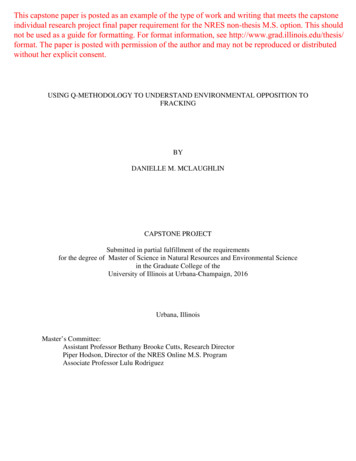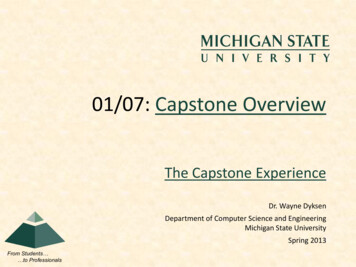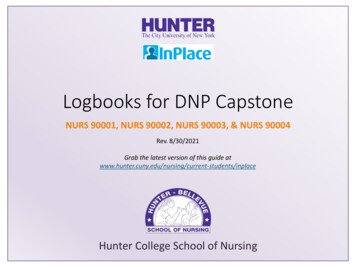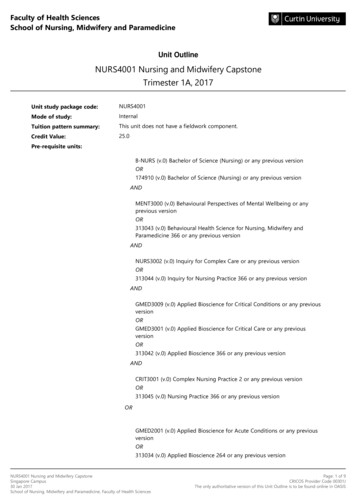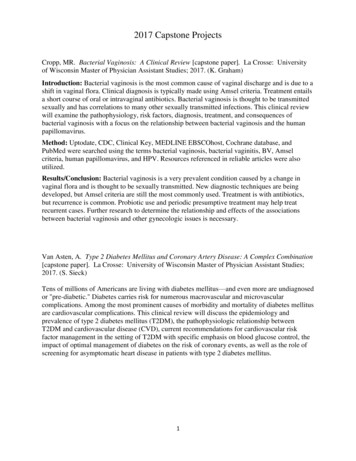
Transcription
2017 Capstone ProjectsCropp, MR. Bacterial Vaginosis: A Clinical Review [capstone paper]. La Crosse: Universityof Wisconsin Master of Physician Assistant Studies; 2017. (K. Graham)Introduction: Bacterial vaginosis is the most common cause of vaginal discharge and is due to ashift in vaginal flora. Clinical diagnosis is typically made using Amsel criteria. Treatment entailsa short course of oral or intravaginal antibiotics. Bacterial vaginosis is thought to be transmittedsexually and has correlations to many other sexually transmitted infections. This clinical reviewwill examine the pathophysiology, risk factors, diagnosis, treatment, and consequences ofbacterial vaginosis with a focus on the relationship between bacterial vaginosis and the humanpapillomavirus.Method: Uptodate, CDC, Clinical Key, MEDLINE EBSCOhost, Cochrane database, andPubMed were searched using the terms bacterial vaginosis, bacterial vaginitis, BV, Amselcriteria, human papillomavirus, and HPV. Resources referenced in reliable articles were alsoutilized.Results/Conclusion: Bacterial vaginosis is a very prevalent condition caused by a change invaginal flora and is thought to be sexually transmitted. New diagnostic techniques are beingdeveloped, but Amsel criteria are still the most commonly used. Treatment is with antibiotics,but recurrence is common. Probiotic use and periodic presumptive treatment may help treatrecurrent cases. Further research to determine the relationship and effects of the associationsbetween bacterial vaginosis and other gynecologic issues is necessary.Van Asten, A. Type 2 Diabetes Mellitus and Coronary Artery Disease: A Complex Combination[capstone paper]. La Crosse: University of Wisconsin Master of Physician Assistant Studies;2017. (S. Sieck)Tens of millions of Americans are living with diabetes mellitus—and even more are undiagnosedor "pre-diabetic." Diabetes carries risk for numerous macrovascular and microvascularcomplications. Among the most prominent causes of morbidity and mortality of diabetes mellitusare cardiovascular complications. This clinical review will discuss the epidemiology andprevalence of type 2 diabetes mellitus (T2DM), the pathophysiologic relationship betweenT2DM and cardiovascular disease (CVD), current recommendations for cardiovascular riskfactor management in the setting of T2DM with specific emphasis on blood glucose control, theimpact of optimal management of diabetes on the risk of coronary events, as well as the role ofscreening for asymptomatic heart disease in patients with type 2 diabetes mellitus.1
Zeamer, L. A Clinical Review of Migraine Headaches [capstone paper]. La Crosse: Universityof Wisconsin Master of Physician Assistant Studies; 2017. (M. Rathgaber)Introduction: Migraine is a highly prevalent chronic disease that can be debilitating to thoseaffected by it. Studies have found it to be a leading cause of disability and one of the maincomplaints presenting to healthcare providers. Due to its widespread prevalence and significantimpact, healthcare providers must have a thorough understanding of this disease and itsmanagement. This review will discuss the epidemiology, pathophysiology, and pharmaceuticalmanagement of episodic and chronic migraine headaches.Method: Cochrane Database, PubMed, MEDLINE, and ClinicalKey were searched using theterms: migraine, migraine headache, treatment, management, prophylaxis, medication,pathophysiology, cause, etiology, epidemiology, cost, and burden. Bibliographies of relevantarticles were reviewed.Results/Conclusion: Migraines are highly prevalent, especially in women, early to middle-agedadults, those of lower income, and Native Americans. The mechanism is not well understood, butis believed to be neurovascular, involving neuronal disturbances that lead to changes in cerebralblood flow. Management of this disease is challenging due to limited understanding and lack ofmigraine-specific interventions. New migraine medications targeting CGRP, a proposedmediator of migraine, are in development and have shown promise in clinical trials. Furtherresearch of this disease and possible treatments are needed in order to improve its management.Rydeen, LC. Pharmacotherapy for Smoking Cessation [capstone paper]. La Crosse: Universityof Wisconsin Master of Physician Assistant Studies; 2017. (A. Baumgartner)Introduction: Smoking tobacco is the most common substance use disorder and continues to bethe leading cause of preventable death in the United States. Many smokers, up to 70%, desire toquit, however, only 6% are able to quit. To aid in smoking cessation, there are currently sevenU.S. Food and Drug Administration approved drugs for smoking cessation: varenicline,bupropion, and five types of nicotine replacement therapies (NRTs). This review will discusseffective pharmacotherapy for smoking cessation based on individual patient needs.Method: EBSCOhost Murphy Library web access portal, Cochrane database, PubMed, andClinicalKey were searched. Bibliographies of relevant articles were reviewed. Seven Cochranereviews, numerous systematic reviews and meta-analysis, many randomized control trials, and aselect number of observational studies were reviewed.Results/Conclusion: Varenicline is the most efficacious pharmacotherapy for smoking cessation(OR 3.85, 95% CI 2.69-5.50). Other first-line pharmacotherapies are NRT (RR 1.87, 95% CI1.43-2.44) and bupropion (OR 1.77, 95% CI 1.19-2.16). There are many new therapies beingresearched and developed, most notably electronic cigarettes (ECs). While EC use continues toincrease, the safety and efficacy is unknown. Further research and development of smokingcessation strategies is needed to improve quit rates among smokers.Keywords: Pharmacotherapy for smoking cessation, varenicline, bupropion, nicotinereplacement therapy, new agents for smoking cessation, electronic cigarettes, barriers to smokingcessation, smoking cessation and pregnancy, smoking cessation and gender, smoking cessationand age, smoking cessation and weight gain, smoking cessation and COPD, lorcaserin forsmoking cessation, cytisine for smoking cessation, and smoking cessation vaccination.2
Lemke, LM. Herpes Zoster: A Clinical Review [capstone paper]. La Crosse: University ofWisconsin Master of Physician Assistant Studies; 2017 (P. Campbell)Introduction: Herpes zoster is caused by reactivation of the varicella zoster virus and affectsapproximately 1 in 3 Americans in their lifetime. This clinical review will address risk factors,epidemiology, presentation, diagnosis, and treatment of herpes zoster. Vaccination against herpeszoster will be discussed in depth.Methods: Uptodate, CDC, AAFP, Cochrane Database, Medline, PubMed, and Clinical Keywere searched using the terms herpes zoster or shingles, varicella, vaccine, vaccination, riskfactors, incidence or prevalence, postherpetic neuralgia, antiviral, and corticosteroid. Applicableresources from reference lists were also utilized.Results/Conclusion: The greatest risk factor for development of herpes zoster is increasing age.Diagnosis is largely clinical, and antiviral treatment should be initiated within 72 hours ofappearance of the rash. The Zostavax vaccine, recommended for adults ages 60 and older,reduces the incidence of herpes zoster by 51.3% and the incidence of postherpetic neuralgia by66.5%. It is most cost-effective when given at age 70. Vaccination rates continue to be low dueto multiple factors, including cost and lack of patient education. A new vaccine, HZ/su, is still inclinical trials, but has shown to be more effective at reducing the incidence of herpes zoster andpostherpetic neuralgia than Zostavax .Benjamin, BM. A Clinical Review of Carpal Tunnel Syndrome with a Focus on the Use ofLocal Corticosteroid Injections for Treatment [capstone paper]. La Crosse: University ofWisconsin Master of Physician Assistant Studies; 2017. (M. Devine)Introduction/Objective: Carpal tunnel syndrome is the most common compressivemononeuropathy seen in clinical practice, and can lead to inconvenient sensory and motorneurological symptoms. This purpose of this review is to discuss the background of carpal tunnelsyndrome and focus on the use of local corticosteroid injections for conservative treatment.Methods: An extensive search of the literature was performed using the Cochrane Database ofSystematic Reviews and MEDLINE. Initial searches included the following search terms:“carpal tunnel,” “treatment,” “therapy,” “ultrasound,” “conservative,” “surg*,” “splint*,”“steroid,” and “injection.”Results/Conclusions: Physical exam findings have sub-optimal sensitivities and specificities inthe diagnosis of carpal tunnel syndrome, so the gold standard of diagnosis is clinical suspicion incombination with electrodiagnostic testing. Although splinting is the often used first-linetreatment for mild-moderate carpal tunnel syndrome, the support is lacking. Local corticosteroidinjections provide short term symptom relief (up to six months), and may have benefit the patientby prolonging the need for surgical intervention. They have been shown to be relatively safe,however, further randomized controlled trials are needed to investigate the ideal location, theeffects on surgical outcomes, and to identify a reliable scale to assess symptom and functionalimprovement.3
Halbach, KE. Preventing Breast Cancer in High-risk women: A Clinical Review [capstonepaper]. La Crosse: University of Wisconsin Master of Physician Assistant Studies; 2017. (S.Sieck)Introduction/Objective: Breast cancer is the leading cancer diagnosis and second leading causeof cancer related deaths for females. High-risk women are identified through risk assessmentmodels and have numerous options for prophylaxis including lifestyle modifications,chemoprevention, and surgery. This paper discusses the effectiveness of these options on riskreduction.Methods: MEDLINE, Cochrane Central Register of Controlled Trials, Cochrane Database ofSystematic Reviews, and PubMed were searched using the MeSH terms listed below.Results: Losing weight and increasing activity have innumerous health benefits, includinglowering the risk of breast cancer. The selective estrogen receptor modulators (SERMs) alsoreduce risk, with tamoxifen being more effective than raloxifene but having higher rates ofendometrial cancer and thromboembolic events. The aromatase inhibitors (AIs) anastrozole andexemestane also reduce risk, but are associated with increased rates of osteoporosis. Two surgicaloptions for risk reduction are mastectomy and oophorectomy. Mastectomy is the most effectiveof all risk reduction options, but is associated with high rates of post-op pain, infection, andseroma.Conclusion: Lifestyle modifications, chemoprevention, and surgery all reduce a patient’s riskfor breast cancer, but the latter two are not without significant risk. An oncologist should weighthe risks and benefits with each individual patient.MeSH terms: breast cancer, risk factors, high-risk, prophylaxis, chemoprevention, tamoxifen,raloxifene, anastrozole, exemestane, SERMs, aromatase inhibitors, lifestyle modifications,mastectomy, oophorectomy.Ramler, JL. A Clinical Overview of Parapneumonic Effusion and Empyema in Pediatrics[capstone paper]. La Crosse: University of Wisconsin Master of Physician Assistant Studies;2017. (K. Graham)Community acquired pneumonia is one of the leading causes of hospitalization for children.Parapneumonic effusions or empyema affect 2 to 12 percent of children with pneumonia, andchildren hospitalized with bacterial pneumonia have a 40% risk of developing a pleural effusion.In the United States, it is estimated that more than 60% of parapneumonic effusion/empyemacases are caused by Streptococcus pneumoniae. Introduction of the 7-valent pneumococcalconjugate vaccination did not lower incidence of parapneumonic effusion and empyema, but newdata demonstrates a decline with the 13-valent pneumococcal vaccine. For children hospitalizedwith parapneumonic effusion and empyema, management varies widely between institutions.Empiric antibiotic selection should be a parenteral third-generation cephalosporin for childrenwith large effusions or empyema. Vancomycin or clindamycin (based on local susceptibilitydata) should be provided in addition to β-lactam therapy if infection caused by Staphylococcusaureus is suspected. If empyema is present, the patient has respiratory compromise, or theopacification on chest radiograph is more than half the hemithorax, tube drainage withfibrinolytic instillation should be performed. Since studies of level 1 evidence show no statistical4
difference of outcomes between fibrinolytics and video-assisted thoracoscopic surgery,fibrinolytics may be considered first line therapy for empyema in children.MeSH terms: Parapneumonic effusion, Empyema, Pleural effusion, Pediatrics, ComplicatedPneumonia, Pneumococcal vaccine, Fibrinolytics, Video-Assisted Thoracoscopic Surgery,Antibiotic therapy, Streptococcus pneumoniae, Hospitalized ChildrenHoffman, LH. An overview of neonatal abstinence syndrome [capstone paper]. La Crosse:University of Wisconsin Master of Physician Assistant Studies; 2017. (M Rathgaber)INTRODUCTION: Neonatal abstinence syndrome (NAS) is a serious medical conditionexperienced by newborn infants that were exposed to addictive, psychoactive substances inutero, most commonly opioids.METHODS: A literature search was performed utilizing the MEDLINE and Cochranedatabases. The search terms used included: “neonatal abstinence syndrome,” “neonatalabstinence,” “neonatal drug withdrawal,” “newborn withdrawal,” “maternal addiction,”“maternal narcotic addiction,” “prenatal drug exposure,” “opioid exposed newborn,” and “opioidexposed neonate.”RESULTS: Common symptoms of NAS include irritability, hypertonicity, tremors, tachypnea,vomiting, fever, difficulties feeding, and failure to thrive. The incidences of opioid abuse andNAS are increasing across the nation resulting in increased length of NICU stays for infants,increased length of hospital stays, and the use of extensive fetal monitoring. Treatment oftenconsists of a combination of both non-pharmacologic and pharmacologic measures, as well asassistance from social services, child protective services, or chemical dependency. Morphine andmethadone are the current first-line pharmacologic agents for infants with NAS. Methadone isthe current gold-standard opioid maintenance therapy with emerging research supporting the useof buprenorphine.CONCLUSION: To successfully prevent NAS, a greater emphasis needs to be placed onadequate screening, education, and standardization of care, and more research is needed.Keywords: buprenorphine, drug withdrawal, heroin, methadone, morphine, neonatal abstinence,neonatal abstinence syndrome, opioid, opioid abuse, prenatal, withdrawalPage, JR. Acute Manifestations of Sickle Cell Disease: Treatment andPprophylaxis [capstonepaper]. La Crosse: University of Wisconsin Master of Physician Assistant Studies; 2017. (M.Devine)Sickle cell disease is a hemoglobinopathy that is estimated to affect 100,000 people in the UnitedStates, as well as millions of people throughout the world. These patients are often affected bysevere acute and chronic manifestations, including vaso-occlusive pain, fever and infection,anemia, splenic sequestration, acute chest syndrome and stroke. While there are someconventionally accepted therapies, including hydroxyurea and blood transfusions, there remainsa lack of effective treatments for these patients. Primarily, the majority of sickle cell diseasepatients in the United States are of African-American or Hispanic descent, and are more likely tobe of low socioeconomic status, be underinsured or uninsured, and have worse access to5
specialized healthcare. Additionally, there is a distinct lack of quality research of current andfuture treatment methods of sickle cell disease. This review aims to analyze the acutemanifestations of sickle cell disease, outline the most current treatments and prophylaxes, andanalyze the barriers to better care of these patients.MeSH Terms: Sickle cell disease, Sickle cell anemia, Hemoglobinopathies, Hydroxyurea, BloodTransfusion, Vaso-occlusive pain, Vaso-occlusive crisis, Fever, Infection, Anemia, Splenicsequestration, Stroke, Disparity, Healthcare, CostFitzgerald, PD. Novel Therapies in the Treatment of Acne Vulgaris [capstone paper]. LaCrosse: University of Wisconsin Master of Physician Assistant Studies; 2017. (A.Baumgartner)Acne vulgaris is a common skin disease, especially in adolescents. The treatment of acne haslargely remained unchanged since the 1970s. Increasing evidence suggests that acne vulgaris hassignificant effects on patient quality of life. This, along with new discoveries in acnepathogenesis and bacterial resistance, has spurned a rising market of acne therapeutic modalities.The guidelines and algorithms for acne treatment are well agreed upon at this point. However,these guidelines may soon be changing as new medications and therapies are showing positiveresults. This review of novel treatments for acne vulgaris will highlight some of the exciting newoptions in acne management.KEYWORDS: acne vulgaris, acne vulgaris treatment, acne vulgaris management, acne vulgaristherapy, acne treatment, acne vulgaris novel agents, isotretinoin, antibiotic resistance.Eichenberg, SE. Babesiosis: A Case Report and Clinical Review [capstone paper]. La Crosse:University of Wisconsin Master of Physician Assistant Studies; 2017. (P. Campbell)Introduction/Objective: Babesiosis is an intraerythrocytic protozoan infection caused byBabaesia sp., most notably Babesia microti. It is endemic to the Northeastern and Midwesternparts of United States and is a nationally reportable disease. The focus of this project is todescribe a case report and clinical review of babesiosis. Method: Literature searches werepreformed via PubMed and Cochrane Library with additional assistance from Mayo Library forarticle retrieval. Keywords can be found in Appendix A. Results: B. microti is transmitted viaticks of endemic areas throughout the summer months. Clinical manifestations of babesiosisinclude nonspecific, febrile illness with characteristic laboratory abnormalities. Disease canrange from asymptomatic infection to fulminant disease. Diagnosis is made via peripheral bloodsmears, PCR, or serologic testing. Treatment with atovaquone plus azithromycin or quinine plusclindamycin leads to resolution of disease. Conclusion: The case report demonstrates the typicalclinical manifestations of babesiosis, as well as the unique development of hemophagocyticlymphohistiocytosis (HLH). Accurate and timely diagnosis of babesiosis requires a high index ofsuspicion by providers of endemic areas, and preventative measures may reduce diseaseoccurrence. Future research will continue to focus on transfusion-transmitted disease andpossibly vaccination.6
Amborn, NE. Point of Care Ultrasound in the Hospitalized Patient [capstone paper]. La Crosse:University of Wisconsin Master of Physician Assistant Studies; 2017. (K. Graham)The performance of ultrasound at the bedside by a healthcare provider rather than a sonographer,with the goal of improving assessment and procedure accuracy, is termed point-of-careultrasound (POCUS). POCUS is rapid, affordable, and non-invasive, but is not currently thestandard of care. This clinical review analyzed the reliability and accuracy of POCUS in thediagnosis and management of decompensated heart failure, pulmonary embolism, pneumonia,and fluid disturbances in hospitalized patients. Articles were identified using Medline, Cochrane,ClincalKey, and PubMed databases. Current research finds POCUS beneficial as an extension ofa physical exam to answer binary questions and help guide differential diagnoses. POCUS isshown to be superior to chest x-ray in the diagnosis of pneumonia, particularly in elderlypatients. POCUS is sensitive and specific for identifying acutely decompensated heart failure.POCUS can also be used to accurately estimate central venous pressure, monitor fluid status, andstratify patients who would benefit from computed tomography pulmonary angiogram in thediagnosis of pulmonary embolism. Additional research is needed to delineate the amount ofeducation needed to accurately perform POCUS, but for trained health care providers, POCUSoffers a rapid, affordable, and non-invasive imaging option for management of hospitalizedpatients.MeSH terms: ultrasound, point-of care ultrasound, heart failure, pulmonary embolism,pneumonia, fluid imbalance, volume status, hospitalized patients, central venous pressurePeeters, EM. A Clinical Review of the Treatment of Acute Pulmonary Embolism [capstonepaper]. La Crosse: University of Wisconsin Master of Physician Assistant Studies; 2017. (M.Devine)Introduction: Pulmonary embolism (PE) is a very prevalent disease in the United States with amortality rate of 10-30%. This review will discuss the treatment options for acute PE. Method:MEDLINE and Cochrane databases were searched to find relevant articles using keywords listedbelow. Results: Non-vitamin K oral anticoagulants (NOACs) have similar rates of venousthromboembolism recurrence but fewer bleeding events compared to warfarin, particularlyapixaban and rivaroxaban (HR 0.31; 95% CI 0.15-0.62) (HR 0.55; 95% CI 0.35-0.89). Optimalduration of anticoagulation is three months for provoked PE and extended for unprovoked if thebleeding risk is low/moderate. Systemic thrombolytics significantly reduces mortality formassive PE (0% vs 100%; P 0.02), but lose significance for submassive PE (OR 0.55; 95% CI0.28-1.08). Other treatment options include surgical embolectomy, catheter-directed techniques,and vena cava filters. Conclusion: Appropriate treatment can be determined by the severity ofthe PE and bleeding risk. First-line treatment for massive PE is thrombolytics, an alternative issurgical embolectomy. Submassive PE can be managed with anticoagulation. Observation isappropriate for subsegmental PE if the risk of recurrence is low, but anticoagulation isrecommended if the risk is high. NOACs are recommended over warfarin because of reducedbleeding risk.Keywords: pulmonary embolism, thromboembolism, treatment, anticoagulation, thrombolytic,NOAC, catheter-directed, embolectomy, inferior vena cava filter.7
Wypyszynski, AM. Medical Cannabis [capstone paper]. La Crosse: University of WisconsinMaster of Physician Assistant Studies; 2017. (P. Campbell)Introduction Cannabis has been used throughout history. Despite its illegal status, it remains awidely utilized drug in the United States. Many states have legalized marijuana for a variety ofmedical indications, however the efficacy and safety of medical cannabis is not well established.Methods A literature search using MEDLINE, PubMed, and Cochrane databases was completedfor cannabis/marijuana/cannabinoids in pain, chemotherapy-induced nausea and vomiting,HIV/AIDS anorexia, multiple sclerosis, epilepsy, and glaucoma. Systematic reviews orrandomized control trials were identified and reviewed for each indication.Results There is moderate quality evidence that oral and smoked cannabis reduce pain, and thatoral cannabinoids improve spasticity in multiple sclerosis. Low quality evidence exists forcannabinoid use in chemotherapy-induced nausea and vomiting. Cannabis has limited evidencefor anorexia in HIV/AIDS, and insufficient evidence in epilepsy and glaucoma. Cannabis hasnumerous side effects and the long-term effects are unknown.Conclusion Current literature shows potential for medical cannabis, specifically in pain andmultiple sclerosis. Research in its long-term effects, use in at-risk populations, and public healthimplications, however, is lacking. As medical marijuana continues to grow in the US, it is crucialthat further studies be completed to determine right the role of cannabis in medicine.Boedeker, W. A Clinical Review of Endometriosis [capstone paper]. La Crosse: University ofWisconsin Master of Physician Assistant Studies; 2017. (S. Sieck)Introduction: Endometriosis is an inflammatory disease of extra-uterine endometrial tissue witha variable presentation, including symptoms of pelvic pain, dysmenorrhea, and dyspareunia1,3. Itis estimated to have a prevalence of 10%2. This clinical review will explore epidemiology,pathophysiology, diagnosis, and treatment of endometriosis.Methods: Medline, Pubmed, and the Cochrane Database were searched using the terms“endometriosis”, “epidemiology,” “pathophysiology,” “diagnosis,” “treatment,” “prognosis,”“cost,” and “finances.” Articles were analyzed for validity and reliability.Results: Pathophysiologic theories include retrograde menstruation, coelomic metaplasia, stemcell theory, estrogen dependence and progesterone resistance, and immunologic predisposition.A non-invasive means for diagnosing endometriosis is under investigation, with weak evidencefor the combined use of serum IL-6 with endometrial PGP 9.5 and pelvic exam with TVUS24.Myriad treatment options include a range of pharmacotherapy and surgery.Conclusion: It is recommended to treat endometriosis in a stepwise approach, beginning withNSAIDs and combination contraceptives and graduating to danazol, GnRHas, aromataseinhibitors, and surgery. Future research should elucidate more targeted approaches to diagnosisand treatment.8
Bedard, MJ. Clozapine for Treatment-Resistant Schizophrenia [capstone paper]. La Crosse:University of Wisconsin Master of Physician Assistant Studies; 2017. (M. Rathgaber)Schizophrenia is a psychiatric disorder affecting about 1% of the world’s population. It is treatedwith 1st and 2nd generation antipsychotics, but one-third of patients continue to have debilitatingsymptoms despite proper treatment. For these patients with treatment-resistant schizophrenia(TRS) clozapine therapy has been the gold standard for many years. Future research with new 2ndgeneration antipsychotics may find a treatment with superior efficacy and a milder side-effectprofile, but current research supports the use of clozapine. Clozapine remains the gold-standardtherapy for treatment-resistant schizophrenia, despite new research investigating other secondgeneration antipsychotics. Judicious use and monitoring of clozapine is warranted for risk ofadverse effects like neutropenia. Knowledge and understanding of the mental illness and itstreatments is essential for primary care. The future of clozapine care lies in community clinics tomonitor serum levels, treatment effects, side-effects, and provide consistent support.Zabadal, ZJ. A Clinical Review and Pharmaceutical Management of Alcohol Use Disorder[capstone paper]. La Crosse: University of Wisconsin Master of Physician Assistant Studies;2017. (A. Baumgartner)Alcohol Use Disorder (AUD) is diagnosed based on recognition of at least two out of elevencriteria outlined in the Diagnostic and Statistical Manual of Mental Disorders, 5 th Edition(DSM-V).1 AUD, as defined by the DSM-V, is present in 14% of adults, with only 19.8%receiving treatment.7 The focus of this review is to provide a brief overview of AUD includingthe selection of the most appropriate pharmaceutical management. AUD is characterized byneurochemical and physical changes in the brain. Chronic alcohol use induces a body-wideinflammatory state and causes various health issues. Recognition of the signs and symptoms ofAUD, along with implementation of screening tools (CAGE, SISQ, AUDIT, and AUDIT-C) areessential for patients to receive proper treatment. FDA-approved medications for AUD includenaltrexone, acamprosate, and disulfiram, with naltrexone and acamprosate displaying moderateimprovement in drinking consumption. Off-label medications such as topiramate, gabapentin,baclofen, and ondansetron have also been studied with mixed results. This paper outlines how torecognize and pharmaceutically treat AUD, including the rationale behind the selection of eachdrug.9
2017 Capstone Projects Cropp, MR. Bacterial Vaginosis: A Clinical Review [capstone paper]. La Crosse: University of Wisconsin Master of Physician Assistant Studies; 2017. (K. Graham) Introduction: Bacterial vaginosis is the most common cause of vaginal discharge and is due to a shift in vaginal flora.



